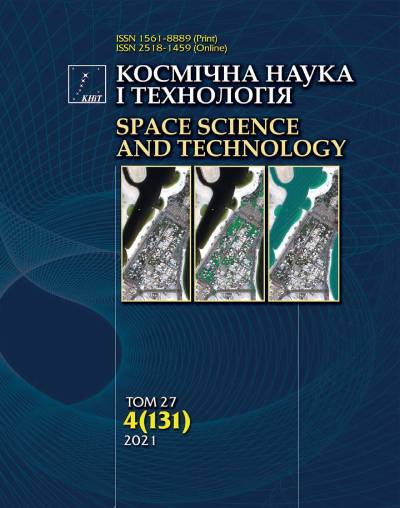Термоміцність відсіку утримання ракети-носія при взаємодії зі струменем продуктів згорання палива
DOI:
https://doi.org/10.15407/knit2021.04.003Ключові слова:
відсік утримання, ракета-носій, струмінь продуктів згоряння палива, теплове нагрівання, термоміцністьАнотація
Термоміцність відсіку утримання розраховується для дослідження можливості його багаторазового використання при пусках ракет-носіїв. Досліджуються нестаціонарні теплові поля відсіку утримання, обумовлені взаємодією газового потоку маршової рухової установки і відсіку утримання. При старті ракети-носія частина корпусу відсіку утримання зазнає значного теплового впливу, що характеризується високими градієнтами температур. Цей тепловий вплив істотно змінюється з плином часу. Внаслідок такого теплового впливу виникають значні динамічні нестаціонарні поля напружень. Нашою метою є розрахунок максимальних величин напружень, індукованих цим тепловим полем. Для цього досліджено напружений стан, індукований стаціонарним тепловим полем, яке відповідає нестаціонарному тепловому полю в момент часу, в який спостерігається максимальний градієнт температур. В такому випадку буде отримана верхня оцінка величин напружень, що виникають в конструкції.Посилання
Mikheev M. A., Mikheeva I. M. (1977). Heat transfer basics. Moscow: Energia.
Duc N. D. (2016). Nonlinear thermal dynamic analysis of eccentrically stiffened S-FGM circular cylindrical shells surrounded on elastic foundations using the Reddy’s third-order shear deformation shell theory. Eur. J. Mech. A. Solids, 58, 10—30.
https://doi.org/10.1016/j.euromechsol.2016.01.004
Elhefny A., Liang G. (2013). Stress and deformation of rocket gas turbine disc under different loads using finite element modeling. Propulsion and Power Res., 2(1), 38—49.
https://doi.org/10.1016/j.jppr.2013.01.002
Jafari M., Jafari M. (2019). Thermal stress analysis of orthotropic plate containing a rectangular hole using complex variable method. Eur. J. Mech. A. Solids, 73, 212—223.
https://doi.org/10.1016/j.euromechsol.2018.08.001
Perakis N., Haidn O. J. (2019). Inverse heat transfer method applied to capacitively cooled rocket thrust chambers. Int. J. Heat and Mass Transfer., 131, 150—166.
https://doi.org/10.1016/j.ijheatmasstransfer.2018.11.048
Ramanjaneyulu V., Murthy V. B., Mohan R. C., Raju Ch. N. (2018). Analysis of composite rocket motor case using finite element method. Materials Today: Proceedings, 5, 4920—4929.
https://doi.org/10.1016/j.matpr.2017.12.069
Song J., Sun B. (2017). Thermal-structural analysis of regeneratively cooled thrust chamber wall in reusable LOX/Methane rocket engines. Chinese J. Aeronautics, 30(3), 1043—1053.
https://doi.org/10.1016/j.cja.2017.04.007
Trabelsi S., Frikha A., Zghal S., Dammak F. (2019). A modified FSDT-based four nodes finite shell element for thermal buckling analysis of functionally graded plates and cylindrical shells. Eng. Structures, 178, 444—459.
https://doi.org/10.1016/j.engstruct.2018.10.047
Trinh M. C., Kim S. E. (2019). Nonlinear stability of moderately thick functionally graded sandwich shells with double curvature in thermal environment. Aerospace Sci. and Technol., 84, 672—685.
https://doi.org/10.1016/j.ast.2018.09.018
Wang Z., Han Q., Nash D. H., Fan H., Xia L. (2018). Thermal buckling of cylindrical shell with temperature-dependent material properties: Conventional theoretical solution and new numerical method. Mech. Res. Commun., 92, 74—80.
https://doi.org/10.1016/j.mechrescom.2018.07.009
Xu F., Abdelmoula R., Potier-Ferry M. (2017). On the buckling and post-buckling of core-shell cylinders under thermal loading. Int. J. Solids and Struct., 126-127, 17—36.
https://doi.org/10.1016/j.ijsolstr.2017.07.024
Yilmaz N., Vigil F., Height J., Donaldson B., Gill W. (2018). Rocket motor exhaust thermal environment characterization. Meas., 122, 312—319.


